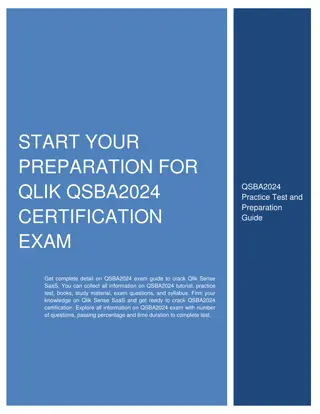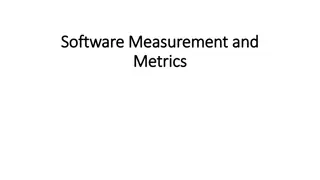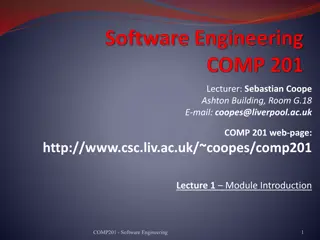Software as a Service: Fundamentals of SaaS
Basics of Software as a Service (SaaS) and its benefits for businesses. Explore cloud computing, scalability, cost savings, and examples of SaaS applications.
Download Presentation

Please find below an Image/Link to download the presentation.
The content on the website is provided AS IS for your information and personal use only. It may not be sold, licensed, or shared on other websites without obtaining consent from the author.If you encounter any issues during the download, it is possible that the publisher has removed the file from their server.
You are allowed to download the files provided on this website for personal or commercial use, subject to the condition that they are used lawfully. All files are the property of their respective owners.
The content on the website is provided AS IS for your information and personal use only. It may not be sold, licensed, or shared on other websites without obtaining consent from the author.
E N D
Presentation Transcript
Software as a Service Fundamentals of SaaS Dr. Jay Sarraf School of Computer Engineering KIIT Deemed to be University
Introduction What is SaaS? SaaS stands for Software as a Service. It is a cloud computing model where software applications are provided to users over the internet. Users access the software through a web browser, eliminating the need for installation and maintenance on their local machines. Cloud Computing With SaaS, users can remotely access the software without the need for installation on their local devices. This model allows businesses to subscribe to the software service with a monthly fee and a pay-as- you-go approach, providing flexibility and cost-effectiveness. Software as a Service Dr. Jay Sarraf, School of Computer Engineering, KIIT Deemed to be University
Cont How Does SaaS Work? SaaS providers host and manage the software applications on their servers. Users access the applications through a client interface, usually a web browser. The provider takes care of software updates, security, and infrastructure management, allowing users to focus on using the software rather than maintaining it. Cloud Computing Software as a Service The future of SaaS Dr. Jay Sarraf, School of Computer Engineering, KIIT Deemed to be University
Benefits of SaaS Benefits of SaaS Cost Savings: SaaS eliminates the need for upfront hardware and software investments, reducing costs for businesses. Scalability: SaaS allows users to easily scale up or down based on their requirements, paying only for the resources they use. Accessibility: Users can access SaaS applications from any device with an internet connection, enabling remote work and collaboration. Easy Updates: SaaS providers handle software updates and patches, ensuring users always have access to the latest features and improvements. Cloud Computing Software as a Service Dr. Jay Sarraf, School of Computer Engineering, KIIT Deemed to be University
Advantages of SaaS for Businesses Advantages for Businesses Rapid Deployment: SaaS applications can be quickly deployed, reducing time-to-market for businesses. Lower Maintenance: With SaaS, businesses don't need to worry about software maintenance, updates, or infrastructure management. Enhanced Collaboration: SaaS applications often include collaboration features, enabling teams to work together seamlessly. Improved Security: SaaS providers implement robust security measures to protect user data, often surpassing what individual businesses can achieve. Cloud Computing Software as a Service Dr. Jay Sarraf, School of Computer Engineering, KIIT Deemed to be University
SaaS Applications Examples of SaaS Applications Customer Relationship Management (CRM) systems like Salesforce. Project Management tools such as Asana and Trello. Communication and Collaboration platforms like Slack and Google Workspace. Accounting Software such as QuickBooks Online and Xero. Cloud Computing Software as a Service Dr. Jay Sarraf, School of Computer Engineering, KIIT Deemed to be University
SaaS vs Traditional Software SaaS vs. Traditional Software SaaS: Pay-as-you-go pricing, no upfront costs, automatic updates, scalable, accessible from anywhere. Traditional Software: Upfront license fees, installation required, manual updates, limited scalability, tied to specific devices. Cloud Computing SaaS Adoption Considerations Data Security: Assess the security measures implemented by the SaaS provider to protect your sensitive data. Service Level Agreements (SLAs): Review the SLAs to ensure the availability and performance of the SaaS application meet your business needs. Integration Capabilities: Check if the SaaS application can integrate with your existing systems and workflows. Vendor Reputation: Research the vendor's reputation, customer reviews, and track record before committing to a SaaS solution. Software as a Service Dr. Jay Sarraf, School of Computer Engineering, KIIT Deemed to be University
SaaS Maturity Model What is SaaS Maturity Model? The SaaS Maturity Model is a framework that helps organizations assess and enhance their capabilities in adopting and leveraging Software as a Service (SaaS). It provides a structured approach to understand the journey from initial adoption to full utilization and optimization of SaaS solutions. Let's explore the different stages of the SaaS Maturity Model. Cloud Computing Software as a Service Dr. Jay Sarraf, School of Computer Engineering, KIIT Deemed to be University
SaaS Maturity Model Stage 1: Ad Hoc At the initial stage, organizations have limited awareness and experience with SaaS. Adoption is ad hoc, with sporadic usage of SaaS applications. There is a lack of standardized processes and governance. The focus is primarily on solving immediate challenges rather than long-term strategy. Cloud Computing Stage 2: Defined In the defined stage, organizations start formalizing their SaaS adoption. There is a clearer understanding of business requirements and alignment with SaaS solutions. Defined processes and governance frameworks are established, ensuring better control and security. However, the usage of SaaS is still limited to specific departments or functions. Software as a Service Stage 3: Managed At the managed stage, organizations have a comprehensive strategy for SaaS adoption. SaaS applications are managed across the organization with standardized processes and controls. Integration with other systems is prioritized, enabling data flow and collaboration. Cost optimization and vendor management strategies are implemented. Dr. Jay Sarraf, School of Computer Engineering, KIIT Deemed to be University
SaaS Maturity Model Stage 4: Optimized In the optimized stage, organizations have fully embraced SaaS and maximize its potential. SaaS solutions are strategically aligned with business goals. Continuous improvement and innovation are emphasized, leveraging analytics and insights to drive optimization. Scalability, security, and performance are key considerations. Cloud Computing Key Benefits of the SaaS Maturity Model: Clear Roadmap: The model provides a roadmap for organizations to progress from initial adoption to optimized utilization of SaaS, ensuring a strategic approach. Governance and Control: It helps establish standardized processes and governance frameworks, enabling better control and security. Integration and Collaboration: Organizations can focus on integrating SaaS applications with other systems, fostering data flow and collaboration. Cost Optimization: The model facilitates cost optimization strategies by evaluating SaaS investments, avoiding redundant applications, and optimizing vendor management. Innovation and Optimization: It encourages organizations to continuously improve and innovate, leveraging insights to drive optimization and gain a competitive edge. Dr. Jay Sarraf, School of Computer Engineering, KIIT Deemed to be University Software as a Service
Consideration for SAAS Application development Cloud Computing Software as a Service Dr. Jay Sarraf, School of Computer Engineering, KIIT Deemed to be University
Important factors for good design of SAAS model A well-designed SaaS application can be distinguished from a poorly designed one based on three key factors: scalability, configurability, and multi-tenancy efficiency. Cloud Computing Scalability: A well-designed SaaS application focuses on maximizing concurrency and efficiently utilizing resources. This involves optimizing factors such as locking duration, statelessness, utilizing shared resources like threads and network connections, caching reference data, and partitioning large databases. Configurability: In a well-designed SaaS application, customization and configuration are achieved without the need for code changes. Each customer should be able to configure the application to meet their specific needs, without affecting other customers. The application should provide simple and easy-to-use tools for customers to configure the appearance and behavior of the application for their users, without incurring additional development or operational costs. Software as a Service Dr. Jay Sarraf, School of Computer Engineering, KIIT Deemed to be University
Important factors for good design of SAAS model Multi-tenancy: A well-designed SaaS application embraces a multi-tenant architecture, allowing multiple companies to use the same application instance simultaneously while ensuring transparency. The architecture should enable efficient sharing of resources across tenants, ensuring optimal utilization and performance. Cloud Computing Software as a Service Dr. Jay Sarraf, School of Computer Engineering, KIIT Deemed to be University
Challenges & Future Trends SaaS Implementation Challenges: Data Migration: Transferring data from existing systems to a SaaS application can be complex and time-consuming. Internet Connectivity: SaaS applications require a stable internet connection for uninterrupted access. Customization Limitations: SaaS applications may have limited customization options compared to on-premises software. Vendor Lock-in: Evaluate the contract terms and exit strategy in case you decide to switch or terminate the SaaS service. Cloud Computing Future Trends in SaaS Industry-Specific Solutions: SaaS offerings tailored to specific industries will continue to grow. Artificial Intelligence (AI) Integration: SaaS applications will increasingly leverage AI capabilities for enhanced functionality and user experience. Internet of Things (IoT) Integration: SaaS solutions will integrate with IoT devices to enable data-driven insights and automation. Hybrid SaaS Models: Hybrid models combining SaaS and on-premises solutions will emerge to meet diverse business requirements. Software as a Service Dr. Jay Sarraf, School of Computer Engineering, KIIT Deemed to be University
Conclusion Software as a Service (SaaS) offers numerous advantages, including cost savings, scalability, and accessibility. Businesses can leverage SaaS to streamline operations, improve collaboration, and focus on core competencies. Cloud Computing As technology continues to evolve, SaaS will play a crucial role in driving digital transformation and innovation. Software as a Service Dr. Jay Sarraf, School of Computer Engineering, KIIT Deemed to be University
Remember Scalability: Plan for growth and optimize resource usage. Security: Prioritize data protection and implement robust security measures. Cloud Computing User Experience: Focus on intuitive interfaces and seamless workflows. Integration: Provide APIs for seamless integration with other systems. Monitoring: Implement monitoring and analytics for performance tracking. Software as a Service Documentation: Offer comprehensive user guides and support resources. Continuous Improvement: Gather feedback and iterate for ongoing enhancements. Dr. Jay Sarraf, School of Computer Engineering, KIIT Deemed to be University























